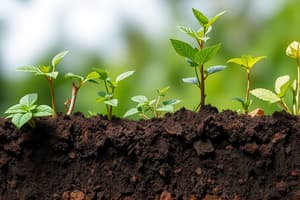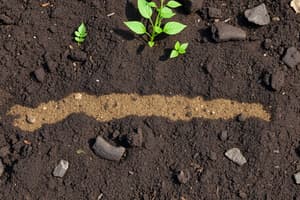Podcast
Questions and Answers
What is the primary composition of clays mentioned in the content?
What is the primary composition of clays mentioned in the content?
- Hydrous aluminum silicates (correct)
- Calcium carbonate
- Iron oxides
- Sodium silicates
How are clay minerals grouped based on the content?
How are clay minerals grouped based on the content?
- According to their crystalline arrangement (correct)
- By their chemical formula
- By their grain size
- Based on their color
What is assumed about the shape of a soil particle in the activity described?
What is assumed about the shape of a soil particle in the activity described?
- Flat disk
- Cubical
- Perfect sphere (correct)
- Irregular
What is the diameter of the soil particle used in the exercise?
What is the diameter of the soil particle used in the exercise?
What is the challenge in the exercise regarding the cylindrical container?
What is the challenge in the exercise regarding the cylindrical container?
What is the primary effect of mechanical weathering on rocks?
What is the primary effect of mechanical weathering on rocks?
Which process is NOT a type of chemical weathering?
Which process is NOT a type of chemical weathering?
What climatic condition significantly enhances mechanical weathering?
What climatic condition significantly enhances mechanical weathering?
What are the three phases that comprise soil according to Geotechnical Engineering?
What are the three phases that comprise soil according to Geotechnical Engineering?
Which of the following is NOT a type of particle that forms soil?
Which of the following is NOT a type of particle that forms soil?
How do chemical weathering processes transform hard rock minerals?
How do chemical weathering processes transform hard rock minerals?
How can soil be separated according to the content?
How can soil be separated according to the content?
Which of the following is NOT one of the principal types of chemical weathering?
Which of the following is NOT one of the principal types of chemical weathering?
What is the result of mechanical weathering in the context of soil formation?
What is the result of mechanical weathering in the context of soil formation?
What is the main focus of Geotechnical Engineering?
What is the main focus of Geotechnical Engineering?
What aspect of soil is essential to understand its properties?
What aspect of soil is essential to understand its properties?
Which of the following describes a key factor in mechanical weathering via temperature changes?
Which of the following describes a key factor in mechanical weathering via temperature changes?
What are the three basic types of soils mentioned?
What are the three basic types of soils mentioned?
In Geotechnical Engineering, the solid particles in soil can be classified into which two categories?
In Geotechnical Engineering, the solid particles in soil can be classified into which two categories?
What is the characteristic difference between soil and rock?
What is the characteristic difference between soil and rock?
What determines the behavior of a structure built on soil?
What determines the behavior of a structure built on soil?
Where are residual soils most commonly found in large areas?
Where are residual soils most commonly found in large areas?
What type of soil is specifically formed by the transportation of materials via glaciers?
What type of soil is specifically formed by the transportation of materials via glaciers?
Which type of transported soil is formed by wind action?
Which type of transported soil is formed by wind action?
Which factor primarily contributes to the plasticity of clay materials?
Which factor primarily contributes to the plasticity of clay materials?
What type of soil formation occurs in quiet lakes?
What type of soil formation occurs in quiet lakes?
Which of the following is NOT a type of transported soil?
Which of the following is NOT a type of transported soil?
What is the range of diameters for grains classified as gravel?
What is the range of diameters for grains classified as gravel?
What are clay materials primarily composed of?
What are clay materials primarily composed of?
What type of soils are formed predominantly from the decay of plant life?
What type of soils are formed predominantly from the decay of plant life?
Colluvial soils are primarily formed through which process?
Colluvial soils are primarily formed through which process?
What process is primarily responsible for forming inorganic soils?
What process is primarily responsible for forming inorganic soils?
Which soil type consists of particles finer than 0.002 mm?
Which soil type consists of particles finer than 0.002 mm?
What soil property is mainly defined by the size of the soil grains?
What soil property is mainly defined by the size of the soil grains?
Which of the following is NOT a characteristic of residual soil?
Which of the following is NOT a characteristic of residual soil?
What defines the lower limit of visibility for soil grains to the naked eye?
What defines the lower limit of visibility for soil grains to the naked eye?
Which statement describes the formation of residual soils?
Which statement describes the formation of residual soils?
Flashcards are hidden until you start studying
Study Notes
Soil and its Constituents
- Soil is defined as a three-phase system comprising solid particles, water, and air.
- In geotechnical engineering, soil refers to solid particles with voids that may contain water; solid particles can be organic or inorganic.
- Soil types include gravel, rock, sand, silt, clay, loam, and humus.
Formation of Soils
- Soils are created from the weathering of parent rocks through mechanical and chemical processes.
- Weathering reduces cohesive forces between mineral grains, leading to smaller soil particles.
Mechanical Weathering
- Mechanical weathering occurs from freezing water, temperature changes, and abrasion from water or glaciers.
- Temperature fluctuations cause stress in rock, resulting in fractures, particularly in arid climates.
Chemical Weathering
- Chemical weathering transforms hard rock minerals into softer, erodible materials through processes like hydration, oxidation, and leaching.
- Water presence enhances reactions between rock elements and atmospheric oxygen or carbon dioxide.
General Types of Soils
- Primary soil types include sand, silt, and clay, with many soils being combinations of these types.
- Soil classification is based on grain size:
- Gravel: 4.75 to 76.2 mm
- Sand: < 4.75 mm but visible to the naked eye
- Silt: 0.075 to 0.002 mm
- Clay: < 0.002 mm
Organic Soils
- Organic soils contain significant amounts of solids derived from decaying plants and small organisms, with peat being a notable example.
Inorganic Soils
- Inorganic soils result from the breakdown of rocks, which occurs via physical weathering or chemical decomposition.
Residual Soils
- Residual soils form through in situ weathering of parent rock and are commonly found in humid tropical regions such as Brazil and the Philippines.
Transported Soils
- Transported soils exist far from their formation sites, moved by glaciers, wind, or water.
- Types:
- Alluvial: formed by running water
- Aeolian: wind-deposited (e.g., sand dunes)
- Colluvial: gravity-driven movement (e.g., landslides)
- Lacustrine: deposited in lakes
- Glacial: deposited by glaciers
- Marine: deposited in seas
Composition of Clay Minerals
- Clay refers to fine particles exhibiting plasticity when mixed with water, primarily consisting of hydrous aluminum silicates.
- Clays are classified into three groups based on crystalline arrangement, influencing their engineering properties.
- Understanding clay mineral structures is crucial for predicting behavior under various loading conditions.
Studying That Suits You
Use AI to generate personalized quizzes and flashcards to suit your learning preferences.




